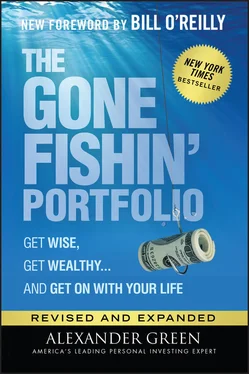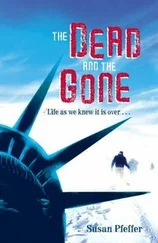2 Put your money to work as I suggest in Chapter 10.
3 Take less than 20 minutes a year to keep this system on track, as I describe in the same chapter.
That's it. If you follow these three simple steps, you'll be on your way to meeting your long-term financial goals—and spending about as much time on your portfolio each year as you would eating lunch at McDonald's.
My objective here is not theoretical. I don't want you to simply read the book, nod your head and say, “Sounds good.” My goal is to encourage you to use this system, to benefit from it. I want to set you on a path to a place where money and its management are no longer a concern in your life.
In essence, the Gone Fishin’ Portfolio is about setting you free from concerns about your financial future. Don't get me wrong. The future, to a great extent, is always uncertain. But you'll enjoy the satisfaction and peace of mind that come from using an investment system that offers a high probability of success. That's not just my opinion, by the way. It's also the opinion of the Nobel Committee. (More on that in Chapter 9.) Trillions of dollars of institutional money are being run using systems similar to the one I'm about to describe.
Incidentally, I've also set up a special website devoted to this investment system. It will allow you to track your progress and will even remind you of the simple steps you need to take once a year to keep your portfolio on track. (Feel free to visit it at GoneFishinPortfolio.com.)
When you're done reading this book, there is only one commitment you'll need to make: a promise to take personal responsibility for your own financial freedom. I can't overemphasize how important this is.
Your employer and the federal government are not going to get the job done for you. Yet for more than two-thirds of elderly Americans, Social Security is their major source of income. (For a third of them, Social Security is their only income.) If you are retired or close to it, you can count on Social Security to help meet your financial needs. But it's tough to imagine living on nothing more.
For young workers, the program is a demographic time bomb. Americans are living longer and healthier lives than ever before. According to the Social Security Administration, the additional life expectancy of a 65-year-old in 1949 was not quite 14 years. Today it is more than 20 years.
By 2035, the number of Americans 65 and older will increase from approximately 56 million today to over 78 million. Yet there are currently 2.8 workers for each Social Security beneficiary. By 2035, there will be only 2.3 workers for each beneficiary.
There is no so-called trust fund. Current payroll taxes are being used to pay out current benefits. Without serious reform—long overdue—our federal pension program looks increasingly like a Ponzi scheme.
(The government's own publications have stated, “The current Social Security system is unsustainable in the long run.”)
Sure, the nation's No. 1 entitlement program will survive in some form, but the solution to the problem is likely to come in the form of higher payroll taxes, an increase in the age of eligibility, and/or fewer benefits. Of course, most of us can only count on Social Security to cover a portion of our retirement expenses.
Private pension plans are going extinct, too. According to the Employee Benefit Research Institute, the share of private-sector workers covered by a defined benefit pension has fallen from 39% in 1980 to less than 4% today. Nationwide, state pensions are underfunded by more than $1.3 trillion. Many corporations have raided their own plans. Others have tried to chisel their way out of them. Some have simply waved the white flag and filed for bankruptcy.
Meanwhile, inflation—the thief that robs us all—is slowly but steadily driving up your cost of living. Your eroding purchasing power means you'll have to devote more of your budget in retirement to housing, utilities, insurance, healthcare costs and other monthly expenses.
This may sound depressing. But by facing the music, you can start making the choices that will provide a comfortable retirement.
Unfortunately, polls show that over half of Americans believe it is the responsibility of the government or their employer to take care of them in retirement. These folks are in for one rude awakening.
You may indeed get benefits from your employer and the federal government. But neither is likely to provide you with a cushy retirement.
That's up to you. As libertarians have insisted for years, responsibility is the price of freedom.
When you take control and accept full accountability for your own financial welfare, you let go of the idea that it is someone else's obligation to provide for you in retirement. You let go of the idea that your broker or financial planner will ensure your financial independence.
Ultimately, your financial welfare is up to you. You need to plan. You need to save. And you need to manage your money intelligently. These are just the topics I'll cover in the pages ahead.
1 The Gone Fishin’ Portfolio is a powerful and effective yet simple investment system to achieve financial freedom.
2 You can enjoy a high probability of success using this investment approach, one that has garnered recognition from the Nobel Committee and is being used—in similar fashion—by many of the world's biggest institutional investors.
3 The investing deck is fundamentally stacked against you. Brokers and financial advisors work for fees. The national media is dependent on advertisers. Accordingly, the Gone Fishin’ Portfolio is designed for skeptical investors seeking objectivity—the unvarnished truth—about their investments.
4 Don't depend on Uncle Sam for all your retirement income. The federal government has said that the current Social Security system is unsustainable in the long run.
5 Americans are living longer than ever. To live well in retirement, you need your portfolio to last as long as possible, too. That's the objective of the Gone Fishin’ Portfolio.
CHAPTER 2 The First Step on the Road to Financial Freedom
My problem lies with reconciling my gross habits with my net income.
Source: Errol Flynn
Before we explore the Gone Fishin’ strategy, let's acknowledge a fundamental truth. There can be no investment without saving. I'm not talking about saving in terms of setting aside money for short-term goals like a new car or a down payment on a house. By saving, I mean giving up immediate spending in exchange for future income.
Saving for your future means setting aside enough money each month to reach your financial goals. Yes, it's partly about planning. But it's mostly about having the discipline to follow through.
According to a recent Federal Reserve report on the economic well-being of U.S. households, just 36% of nonretired adults believe their retirement saving is on track. A quarter of adults have no retirement savings or pension at all.
A few years ago, a survey by Bankrate.comfound that 68% of adults avoid news about the cost of retirement. Why do so many Americans have their heads in the sand? There are various reasons. Some see their parents living fairly well on Social Security and pensions. Others simply lack the discipline to save. In a Fidelity survey, only about a quarter of respondents said they would make a lifestyle change now to save for later.
These folks might want to go back and read Aesop's fable about the ant and the grasshopper. As I stated in the previous chapter, Americans are living longer than ever thanks to healthier lifestyles and modern medicine.
If you're likely to live longer, you need a hardworking investment portfolio (one that can duck into a phone booth and come out with a red cape unfurled). But to truly maximize the size of that portfolio, you'll need to save as much as you reasonably can, as soon as you can, for as long as you can.
Читать дальше












